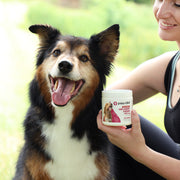We usually think of dogs as outdoor-loving creatures who can’t wait for their next walk or potty break. The sights smells, and sounds of the outdoor world are often stimulating and exciting for a canine. So it can be troubling and worrisome for pet parents to discover their dog doesn’t want to leave the house.
If you notice your pooch consistently expressing reluctance – or maybe even flat-out refusal – to go outside for a walk, bathroom break, or other outdoor adventure, the issue needs to be addressed swiftly. Going outside is an important part of a dog’s quality of life, and their disinterest in outdoor activities could be symptomatic of a larger and more serious problem. Here are some possible reasons why your dog doesn’t want to leave the house, and some strategies for helping them overcome this issue.
5 Reasons Why Your Dog Doesn’t Want to Leave the House
Your dog’s refusal to go outside can be caused by a few different things, such as:
- Medical issues
- Separation anxiety
- Noise sensitivity
- Bad previous experiences or trauma
- Weather or climate discomfort
Your Dog May Not Want to Go Outside Because of Injury or Illness
If your dog is reluctant to go outside, rule out any pain or medical issues that might be making them uncomfortable. If walking and spending time outside hurts them, it makes sense that they won’t want to do it.
If your dog is getting older, they might be experiencing early symptoms of arthritis and joint pain that is making outdoor time harder for them. Your dog might also have an injury to their leg or paw, or even simply an ingrown or ripped toe nail. If your dog doesn’t want to go out because they seem especially lethargic, or fatigued and tired all the time, this can also be an indicator of other serious health issues.
A physical examination at home might help you identify the problem, but you should also consult your veterinarian to be sure that pain or a medical condition isn’t the reason your dog doesn’t want to leave the house.

Separation Anxiety Might Make Your Dog Nervous to Leave the House
If your dog suffers from separation anxiety and gets really upset when they are away from you, this could contribute to their reluctance to leave the house – even if they are doing so with you at their side. Your dog might associate your departure with discomfort and fear, so when you suggest it’s time for a walk or for them to go outside for a bathroom break, they begin to panic about being away from you.
It may seem surprising that going on an outdoor adventure with you would trigger your dog’s separation anxiety, but they don’t necessarily know what you have in store for them. They might be concerned that leaving the house means leaving you.
The Outdoors Can Be Noisy, Unpredictable, and Scary for a Dog
Simple fear of the unknown could be the reason your dog doesn’t want to leave the house. Within your home, your dog knows what to expect and feels safe and comforted (especially if they have their very own doggie safe space). Outside, there are a lot of unpredictable variables, from loud noises to other people and animals.
Noise aversion can be a very real struggle for many dogs because their hearing is so sensitive. If you live in a particularly noisy area with traffic and lots of activity, your dog might feel overwhelmed when they go outside. Likewise, if your dog isn’t properly socialized or trained, they might feel nervous and scared of other dogs and people. These are all triggers that can be present in the world that will make them less inclined to venture outside with you.
One Bad Experience Can Stay With a Dog for a Long Time
Some dogs don’t want to go outside because of previous trauma or bad memories. This could be something obvious and significant – such as getting hit by a car or getting into a fight with another dog – or something very tiny that you didn’t even notice, like them slipping off the curb or being startled by a car backfiring.
If your dog is adopted, it’s also possible that the previous owners left them outside for too long and perhaps without proper shade, water, and other necessities. If they have these negative memories of being forgotten outdoors, it makes sense that they won’t want to leave the house.
Your dog stores memories in the same way you do, and because we can’t explain scary experiences to them, sometimes those experiences cause complexes and trauma. If your dog doesn’t like to leave the house, think back on your previous outdoor adventures together and see if you can remember an experience that might have disturbed them.
Temperature and Weather Can Impact a Dog’s Desire to Leave the House
Climate and weather are an important consideration when taking your dog outside, even just for a quick potty break. Dogs are very at risk for overheating, and they’re also often disturbed by thunderstorms. If your dog has had their paws burned by a hot sidewalk or gotten caught in a scary, loud storm during a previous walk or outdoor time, they might become reluctant to leave the house for future walks or potty breaks.
How to Support a Dog That Doesn’t Like Leaving the House
Once you’ve figured out why your dog doesn’t want to leave the house, you can be more effective in supporting them. But sometimes even the best pet parent detectives won’t be able to find the root cause of their dog’s reluctance to go outdoors. Here are some strategies you can try to encourage your pooch to enjoy outdoor time rather than dread it:
- Treats and positive reinforcement
- Identify triggers and try to desensitize
- Choose the right time, weather, and location for outdoor experiences
Condition Your Dog to Love Leaving the House with Treats and Positivity
The quickest and most effective way to help a dog that doesn’t want to leave the house is with counter-conditioning. This takes the negative experience of leaving the house and turns it into a positive one, so your pet is willing and excited rather than fearful and reluctant.

Lure your pet outside with treats. Start by doing this without a leash, harness, or other item that signals a walk. Simply offer them a yummy, healthy treat (blueberries are a popular choice because they are small and low-calorie, so less likely to mess up your dog’s daily diet) and keep feeding them as they come out the door. Provide them with plenty of praise and encouragement while they’re walking out and once they’re outside. Using this same strategy, slowly graduate to other steps of the process, such as putting on their leash or walking down the block.
Never punish your dog for not wanting to leave the house. Dogs are instinctual creatures and they are not trying to be difficult or petulant. If your dog doesn’t want to leave the house, he has a reason. It’s up to you to make the experience positive and pleasant so they look forward to outdoor activities.
Figure Out What Is Triggering Your Dog and Slowly Desensitize Them
If you can identify a trigger, such as your loud lawn mower or a barking dog down the street, that is making your dog not want to leave the house, you can help by desensitizing them to this experience slowly. This means exposing your dog to the trigger in small, incremental steps so they get used to whatever is bothering them.
For example, you might bring your dog over to your mower when it’s off and in the shed, then again when the machine is off and in the yard, then crank it up but not move it. Finally, move around a little with the mower. This would all happen over the course of several days or weeks to get your dog used to the mower itself and the noise it makes, so he’s no longer afraid.
The desensitization process is very delicate and has the potential to further traumatize your dog if not done correctly, so be careful, move slowly, and consult your veterinarian or an animal behavioral specialist for help.
Choose the Right Time and Location for Outdoor Experiences
Ensure your dog’s outdoor experiences are positive by choosing the right weather, time of day, and location for their walks and potty breaks. Try not to walk your dog during the hottest parts of the day and always be sure to have water on hand during the summer months. You might consider dog booties if your pet has sensitive feet and finds snowy sidewalks or hot pavement uncomfortable.
If your neighborhood is full of triggers like other dogs and loud cars, try taking your pet for walks in other locations such as nearby parks or greenways. If your dog is reluctant to go into your backyard for a potty break, try to make the yard more inviting with toys, shade, and water. The setting of your dog’s outdoor time will determine how much they enjoy it, which will determine whether or not they want to leave the house next time.
Outdoor Time Is Important, So Help Your Dog Enjoy It
If your dog doesn’t want to leave the house, it’s important that you take an active role in changing their attitude. The outdoors is full of pleasant and happy experiences for dogs, and walks are also a crucial part of their physical wellness. Don’t let your dog remain reluctant to go outside – use these strategies to ensure your pooch can’t wait for their next outdoor adventure!






